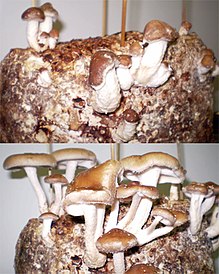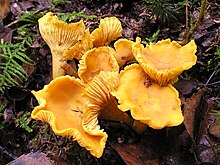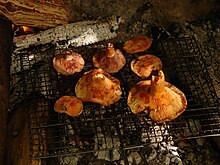Edible mushroom

An edible mushroom is a mushroom that can potentially be safely eaten, including thousands of types of mushrooms that are regularly harvested. Some species that cannot be easily cultivated, such as the truffle or matsutake, are highly prized. On the other hand, some edible mushrooms may have extremely bad taste, such as the Bitter bolete mushroom.
Before assuming that any wild mushroom is edible, check safety rules and be sure of its identification. There is no "test" for edibility other than identifying the species. Even mushrooms that are edible for most people can cause "allergic" reactions in some individuals.
History of mushroom use
This article needs attention from an expert on the subject. Please add a reason or a talk parameter to this template to explain the issue with the article. |
The pharaohs of Egypt enjoyed mushrooms so much, that they decreed mushrooms could only be eaten by royalty and that no commoner could even touch them, thus giving the royal family the entire available supply. In some parts of Eurasia, especially in Russia and Nordic countries, mushrooms are an important part of the diet. Several mushrooms are especially tasty and many are rich on nutrients. Mushrooms are also easily preserved, and historically have provided additional nutrition over winter.
Many prehistoric and a few modern cultures around the world used psychedelic mushrooms for ritualistic purposes. Before 10,000 BCE while people were still hunting and gathering as a part of every day life, women did the gathering. Women were said to be blessed with the ability to see in the dim light so they were successful in foraging for mushrooms and fungi amongst other things [citation needed]. Mushroom cultivation reached the United States in the late 1800s with imported spores from Mexico. Some species such as death cap are extremely poisonous and have been deliberately used as instruments of assassination.[citation needed]
Mycophagy (mai'kɒfədʑi), the act of consuming mushrooms, dates back to the times of ancient Roman Caesars. They would have a food taster taste the mushrooms before the Caesar to make sure they were safe.
Current culinary use
A fraction of the many fungi consumed by humans are currently cultivated and sold commercially. Pioneers such as Paul Stamets are introducing more into cultivation. Commercial cultivation is important ecologically, as there have been concerns of depletion of larger fungi such as chanterelles in Europe, possibly because the group has grown so popular yet remains a challenge to cultivate.
Commercially cultivated fungi

Mushroom cultivation has a long history.
- Agaricus bisporus, also known as champignon and the button mushroom. This species also includes the portobello and crimini mushrooms.
- Agaricus campestris - Meadow mushroom
- Auricularia polytricha or Auricularia auricula-judae (Tree ear fungus), two closely related species of jelly fungi that are commonly used in Chinese cuisine.
- Flammulina velutipes, the "winter mushroom", also known as enokitake in Japan
- Hypsizygus tessulatus (also Hypsizygus marmoreus), called shimeji in Japanese, it is a common variety of mushroom available in most markets in Japan. Known as "Beech mushroom" in Europe.
- Lentinus edodes, also known as shiitake, oak mushroom. Lentinus edodes is largely produced in Japan, China and South Korea. Lentinus edodes accounts for 10% of world production of cultivated mushrooms. Common in Japan, China, Australia and North America.
- Pleurotus species, The oyster mushroom and king trumpet mushroom. Pleurotus mushrooms are the second most important mushrooms in production in the world, 25% of total world production of cultivated mushrooms. Pleurotus mushrooms are world-wide, China is the major producer. Several species can be grown on carbonaceous matter such as straw or newspaper. In the wild they are usually found growing on wood.
- Pleurotus cornucopiae
- Pleurotus eryngii
- Pleurotus ostreatus (Oyster mushroom)
- Rhizopus oligosporus - the fungal starter culture used in the production of tempeh. In tempeh the mycelia of R. oligosporus are consumed.
- Sparassis crispa - recent developments have led to this being cultivated in California.
- Tremella fuciformis (Snow fungus), another type of jelly fungus that is commonly used in Chinese cuisine.
- Tuber species, (the truffle), Truffles belong to the ascomycete grouping of fungi. The truffle fruitbodies develop underground in mycorrhizal association with certain trees e.g. oak, poplar, beech, and hazel. Being difficult to find, trained pigs or dogs are often used to sniff them out for easy harvesting.
- Tuber aestivum (Summer or St. Jean truffle)
- Tuber magnatum (Piemont white truffle)
- Tuber melanosporum (Perigord truffle)
- T.melanosporum x T.magnatum (Khanaqa truffle)
- Terfezia sp. (Desert truffle)
- Ustilago maydis (Corn smut), a fungal pathogen of the maize plants. Also called the Mexican truffle, although not a true truffle.
- Volvariella volvacea (the "Paddy straw mushroom.") Volvariella mushrooms account for 16% of total production of cultivated mushrooms in the world.
Commercially harvested wild edibles



Some species are difficult to cultivate, others (particularly mycorrhizal species) have not yet been successfully cultivated. Some of these species are harvested from the wild, and can be found in markets. When in season they can be purchased fresh, and many species are sold dried as well. The following species are commonly harvested from the wild:
- Boletus edulis or edible Boletus, native to Europe, known in Italian as Fungo Porcino (plural 'porcini') (Pig mushroom), in German as Steinpilz (Stone mushroom), in Russian as "white mushroom", and in French the cep. It also known as the king bolete, and is renowned for its delicious flavor. It is sought after worldwide, and can be found in a variety of culinary dishes.
- Cantharellus cibarius (The chanterelle), The yellow chanterelle is one of the best and most easily recognizable mushrooms, and can be found in Asia, Europe, North America and Australia. There are poisonous mushrooms which resemble it, though these can be confidently distinguished if one is familiar with the chanterelle's identifying features.
- Clitocybe nuda - Blewit (or Blewitt)
- Cortinarius caperatus the Gypsy mushroom (recently moved from genus Rozites)
- Craterellus cornucopioides - Trompette du Mort or Horn of Plenty
- Grifola frondosa, known in Japan as maitake (also "hen of the woods" or "sheep’s head"); a large, hearty mushroom commonly found on or near stumps and bases of oak trees, and believed to have medicinal properties.
- Gyromitra esculenta this "False morel" is prized by the Finns. This mushroom is deadly poisonous if eaten raw, but highly regarded when parbroiled (see below).
- Hericium erinaceus, a tooth fungus; also called "lion's mane mushroom."
- Hydnum repandum Sweet tooth fungus
- Lactarius deliciosus Saffron milk cap - Consumed around the world and prized in Russia
- Morchella species, (morel family), morels belong to the ascomycete grouping of fungi. They are usually found in open scrub, woodland or open ground in late spring. When collecting this fungus, care must be taken to distinguish it from the poisonous false morels, including Gyromitra esculenta.
- Morchella conica var. deliciosa
- Morchella esculenta var. rotunda
- Tricholoma matsutake the Matsutake, a mushroom highly prized in Japanese cuisine.
- Tuber species, (the truffle), Truffles have long eluded the modern techniques of domestication known as trufficulture. Although the field of trufficulture has greatly expanded since its inception in 1808, several species still remain uncultivated. For a list of domesticated truffles, see above.
- Tuber borchii
- Tuber brumale
- Tuber indicum - Chinese black truffle
- Tuber macrosporum - White truffle
- Tuber mesentericum - The Bagnoli truffle
- Tuber uncinatum - Black summer truffle
Other edible wild species
Many wild species are consumed around the world. The species which can be identified "in the field" (without use of special chemistry or a microscope) and therefore safely eaten vary widely from country to country, even from region to region. This list is a sampling of lesser-known species that are reportedly edible.

- Amanita caesarea
- Armillaria mellea
- Boletus badius
- Boletus elegans
- Chroogomphus rutilus
- Calvatia gigantea (Giant Puffball)
- Clavariaceae species (coral fungus family)
- Clavulinaceae species (coral fungus family)
- Coprinus comatus, the Shaggy mane. Must be cooked as soon as possible after harvesting or the caps will first turn dark and unappetizing, then deliquesce and turn to ink. Not found in markets for this reason.
- Cortinarius variecolor
- Fistulina hepatica
- Hygrophorus chrysodon
- Lactarius salmonicolor
- Lactarius volemus
- Laetiporous sulphureus (Sulphur shelf). Also known by names such as the "chicken mushroom", "chicken fungus", sulphur shelf is a distinct bracket fungus popular among mushroom hunters.
- Leccinum aurantiacum (Red-capped scaber stalk)
- Leccinum scabrum (Birch bolete)
- Lepiota procera
- Polyporus squamosus
- Polyporus sulphureus
- Ramariaceae species (coral fungus family)
- Rhizopogon luteolus
- Sparassis crispa. Also known as "cauliflower mushroom".
- Suillus bovinus
- Suillus luteus
- Tricholoma terreum
Conditionally edible species
There are a number of fungi that are considered choice by some and toxic by others. In some cases, proper preparation can remove some or all of the toxins.
- Amanita muscaria is edible if parboiled to leach out toxins.[1]. Fresh mushrooms are hallucinogenic and may cause seizures or coma due to the presence of ibotenic acid.
- Coprinopsis atramentaria is edible without special preparation. However, consumption with alcohol is toxic due to the presence of coprine. Some other Coprinus spp. share this property.
- Gyromitra esculenta is eaten by some after it has been parboiled; however, mycologists do not recommend it. Raw Gyromitra are toxic due to the presence of gyromitrin, and it is not known if all of the toxin can be removed by parboiling.
- Lactarius spp. - Apart from Lactarius deliciosus which is universally considered edible, other Lactarius spp. that are considered toxic elsewhere in the world are eaten in Russia after pickling or parboiling[2].
- Verpa bohimica - Considered choice by some, it even can be found for sale as a "morel", but cases of toxicity have been reported. Verpas contain toxins similar to gyromitrin[3] and similar precautions apply.
Mushroom black market
Several mushroom species are cultivated or collected for use in a recreational or ritualistic context. These mushrooms all have hallucinogenic properties and for this reason they are typically not considered edible. Whereas edible mushrooms are commonly defined by their comestibility and hallucinogenic mushrooms are not comestibles, they are nevertheless eaten and when taken in appropriate doses, the mycotoxins present in the mushrooms will be metabolized by the eater and their effects will disappear within several hours.
- Agrocybe farinacea - collected in Japan. Contains psilocybin.
- Amanita muscaria - Commonly used for shamanistic purposes by the peoples of Siberia, Turkic peoples, the Sami people, and others. Contains ibotenic acid, muscarine, muscimol.
- Conocybe spp. - Used for shamanic purposes by the Mazatecs of Oaxaca. [4] Contains psilocin and psilocybin.
- Copelandia spp. - Commonly growing in Hawaii. Contains psilocin and psilocybin
- Galerina steglichii - Rare and rarely collected. Contains psilocybin, alpha-amanitin and other amatoxins.
- Gerronema fibula- A tropical mushroom.
- Gerronema solidipes - A tropical mushroom.
- Gymnopilus spp. - Commonly bitter in taste, recreational use is uncommon with most species. [1] Contains psilocybin, bis-noryangonin, and hispidine. [5]
- Hypholoma spp. - Contains psilocybin. [2]
- Inocybe spp. - Contains muscarine, psilocybin, and aeruginascine.
- Mycena cyanorrhiza - Contains psilocybin.
- Panaeolus spp. - Collected and cultivated for recreational use.[3] Contains psilocybin, psilocin, serotonin, urea, and tryptophan. [6]
- Pluteus spp. - Contains psilocybin [7]
- Psilocybe spp. - cultivated for its hallucinogenic properties. These species contain the mycotoxins: psilocybin, psilocin, baeocystin, norbaeocystin, and occasionally other psychoactive tryptamines.
- Weraroa novae-zelandiae
Preparing wild edibles
Some wild species are toxic, or at least indigestible, when raw. As a rule all wild mushroom species should be cooked thoroughly before eating. Many species can be dried and re-hydrated by pouring boiling water over the dried mushrooms and letting them steep for approximately 30 minutes. The soaking liquid can be used for cooking as well, provided that any dirt at the bottom of the container is discarded.
See also
References
- ^ » Amanita Muscaria
- ^ Arora, David. Mushrooms Demystified, 2nd ed. Ten Speed Press, 1986
- ^ IMPORT ALERT IA2502
- ^ [Heim and Wasson (1958)]
- ^ G. M. Hatfield, L. R. Brady (1969). "Occurrence of bis-noryangonin in Gymnopilus spectabilis". Journal of Pharmaceutical Sciences. 58 (10): 1298–1299.
{{cite journal}}: Unknown parameter|quotes=ignored (help) - ^ Paul Stamets (1996). "8". Psilocybin Mushrooms of the World. Ten Speed Press. p. 245.
- ^ G. Guzmán, J. W. Allen & J. Gartz, "A Worldwide Geographical Distribution of the Neurotropic Fungi, an Analysis and Discussion"
